
Tucson farrier George Goode stands in his mobile horseshoeing trailer, which he drives to tribal lands to teach students the trade. (Noor Haghighi)
Students pick up a plastic painter’s bucket of tools on the first day of class.
Inside the white pail are 14 items, including: clinchers, a hook knife, rasp, cutting nippers, an apron, hammers, a foot gauge, a hoof stand and an equine leveler.
By day three, the utensils and devices are used throughout the 12-week horseshoeing course. Students shape shoes, cut hooves and learn to calm a horse.
The implements are worth $1,800. And the lessons master farrier George Goode imparts are for a lifetime.
Lesson: Feet are foundational and need protection. They can carry you where you need to go, absorb impact, carry weight.
Lesson: Take care of the hoof — which is the base — it protects the horse and by doing so, you also tend to your farm and your finances.
From the tribal lands of the Dakotas to New Mexico and Northern Arizona, the 85-year-old travels and works to advance his mission of teaching his students, most of whom are Indigenous, how to shoe horses.
Goode has a personal connection to Indigenous communities because of his Pascua Yaqui heritage and a former spouse and kids who identified as Tohono O’odham. He travels the country in his truck and trailer with his mobile horseshoeing business inside — to educate students as farriers, businesspeople and to care about animals.
“I want to put jobs on the reservation and I want to show them they can take care of their livestock forever,” Goode said. “We think of them as a piece of machinery. But your horse can feel a fly on its back.”
Through his courses — at a minimum of three days and up to 12 weeks — Goode gives students the skills to trim and shoe a horse and the knowledge to return to tribal lands and start a business and take care of their family, including horses.
“We give them a job that provides structure within their culture,” Goode said. “If we have 10 students and that’s 10 families that have their horses and maybe their neighborhood horses — all taking care of their own livestock forever. It’s education.”
That schooling is key at Tohono O’odham Community College where Goode’s class is offered each spring. TOCC administrators aim to expand that program and others including solar installation and culinary arts after the workforce Pell grant was signed into law as part of the federal domestic spending bill earlier this month. His 12-week course would cost just under $20,000 for a non-college student.
“Beyond professional opportunities, the program fosters a profound cultural and spiritual connection between the O’odham and their horses, particularly among the youth,” said Adrian Quijada, director of the Land Grant Office of Sustainability at Tohono O’odham Community College. “It represents a pathway to economic self-reliance while honoring and strengthening the age-old bond between the community and their equine companions.”
Finding the foundation
For more than 60 years, Goode has donned his chaps, melted and soldered horseshoes and connected with equines.
Before he earned a master’s in equine science at Cal Poly San Luis Obispo, he was born in Silver City, New Mexico and grew up on Tucson’s south side. He spent summers picking cotton in what is now Marana.
“They had a horseshoeing course there at the college. So I took the course and I liked it,” he said. “When I got out, the guys were using their degrees. … I went to horseshoeing, so I’ve been into this field all my life.”
Goode started the Tucson School of Horseshoeing in 1973 and had a family, including four kids. On the far east side, students came from all over the world to learn the trade. In 2018, he sold the school. It folded two years later, he said.
His vision of teaching Indigenous people how to care for their horses was shaped in 2006 when he founded the nonprofit Native American Horse Education Foundation.
But the loss of his three sons and caregiving for his wife, Sue, who had Alzheimer’s, delayed the dream. Then, he used his fundamental patience and kindness to share his knowledge.
He started simple: The foundation of a horse is their feet.
Take care of the foot, you take care of the horse.
“The horses usually stand when they sleep,” Goode said. Proper care of a horse’s feet can extend their life five, 10 more years, he said.
As he travels to tribal lands, Goode’s horse education course extends to elementary kids. He shows them why footcare matters. He uses props as he talks, displaying a horse leg, showing bone structure and hooves.
This anatomy lesson was key for Oriana Apkaw, an Indigenous student at Tohono O’odham Community College. She commuted two hours a day from her family’s ranch in the village of Kohatk to Sells for the horseshoeing class in 2024.
“YOU can take care of your animal,” said Apkaw, 31. “It’s your family member.
“The more people that have contacted me about horseshoeing, I go see the hooves and some of it is really bad,” she said. “But they just don’t know.”
Apkaw now trims and shoes her seven horses and fields calls from neighbors and family members to do their horses. She also works full time as a recreation specialist at the Tohono O'odham Ki:Ki Association.
“I see (horseshoeing) as a side job,” she said. “It’s extra income I went to school for.”
Workforce Pell at work
Apkaw’s tuition was free at TOCC. And the Pell grant expansion could help others like her, said Stephen Schoonmaker, president of Tohono O’odham Community College.
Workforce Pell opens Pell grants to people interested in shorter, career-focused programs.
“Workforce Pell is huge for us because when we offer these kinds of certification programs, now this will qualify,” Schoonmaker said, adding a farther-reaching Pell grant allows a student to use the money for rent and food. Students can live and go to school.
In many cases, Pell grants are used for living expenses and not tuition.
They are the main form of federal aid for low-income students and are key because they do not need to be paid back and are generally for undergraduate students.
More than six million college students use Pell grants, including 124,000 in Arizona students, whose grants each averaged about $4,500 in the 2022-23 school year, according to the National Center for Education Statistics.
Workforce Pell grants allow students to earn certifications through training from an accredited school and enter the workforce. And that is a focus of Tohono O’odham Community college with about 1,200 students, Schoonmaker said. TOCC’s emphasis spurred a vision for Quijada who met Goode in 2022 and knew the community college could use this program. It lifted off when the two teamed for a grant for certification in farrier skills through the Native American Agriculture Fund, Quijada said.
“George spoke with such reverence for the cultural significance of horses within Native American traditions and the invaluable role they play in the lives of the O’odham people. His understanding of horse health and the critical importance of proper hoof care was unparalleled, and it was clear that this program wasn’t just about technical training,” Quijada said. “George’s vision and dedication left a deep impression on me, and I knew I wanted to be part of turning this dream into reality.”
A balance of tender and tough
Goode’s next plan is a horseshoeing facility — somewhere — with boarding, he says, so Indigenous people from all over can learn the trade.
“The people I train, they go back (to tribal lands). But it’s like a drop in a bucket,” he said. “I proposed a horseshoeing school for all of the nations. The guys can come in from Montana, wherever.”
Finding the funding for this effort is the biggest challenge, Goode said, as he continues to teach and spread the word through his students and his travels. This week, he heads to the San Carlos Apache Reservation to talk with students.
Goode is one of more than 25,000 farriers in the United States, according to The Farrier Guide. The U.S. is also home to fewer than 30 farrier schools, according to the American Farrier Association.
Shoeing a horse can cost between $100 to $400 for a set of four shoes, depending on the service and the farrier. Horses need trimming and shoeing every six to eight weeks.
Think of manicures and pedicures, Apkaw said. “It’s like nail maintenance,” she said. “When I was learning technique, I was thinking about my own nails. You get on a schedule.”
In the last three months, she’s done just under 20 horses and says a farrier is also in good physical shape. “To hold the horse and be crouched down, you have to gain muscle memory to do it. Especially if a horse isn’t going to stand for you, you have to give it a bit more strength.”
Goode balances that toughness with tenderness for his students. When a trio of female farrier students brought him an unruly horse during a class in Chinle, he trusted the students to calm the horse. And when they finished at the top of the class — in shoeing the horses, making the shoes and on written tests — he came through on a promise to them: manicures.
“I told them if they did well, I would take them to get their nails done,” he said. “They did it. And I took them.”
Goode’s method has worked for nearly 60 years.
“His holistic approach ensures that his teachings extend beyond the classroom, equipping students with both the technical expertise and practical life skills needed for long-term success,” Quijada said. “Beyond the technicalities of horseshoeing, he emphasizes the importance of financial literacy, providing insights into managing costs, setting pricing for services, and tools for building a sustainable and profitable business.”
We can put people to work, Goode said. It’s a necessity — for students and their horses.
“We hope some work ethic sets in. I want to leave them with good communication, good attitude, kindness, honesty,” he said. “Be honest. Be kind. Be fair. Have a standard. If you keep on those things, you’re going to be fine.”
This article first appeared on AZ Luminaria and is republished here under a Creative Commons Attribution-NoDerivatives 4.0 International License.

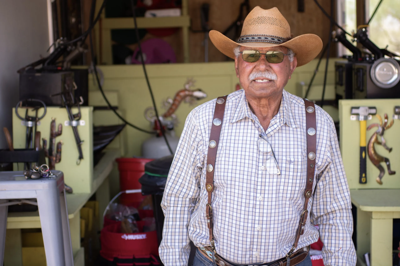
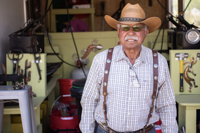


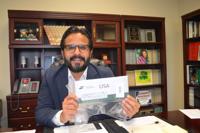


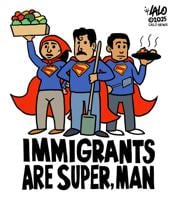
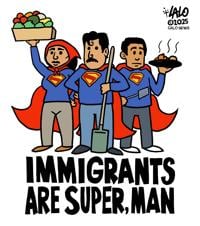

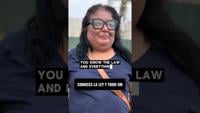
(0) comments
Welcome to the discussion.
Log In
Keep it Clean. Please avoid obscene, vulgar, lewd, racist or sexually-oriented language.
PLEASE TURN OFF YOUR CAPS LOCK.
Don't Threaten. Threats of harming another person will not be tolerated.
Be Truthful. Don't knowingly lie about anyone or anything.
Be Nice. No racism, sexism or any sort of -ism that is degrading to another person.
Be Proactive. Use the 'Report' link on each comment to let us know of abusive posts.
Share with Us. We'd love to hear eyewitness accounts, the history behind an article.